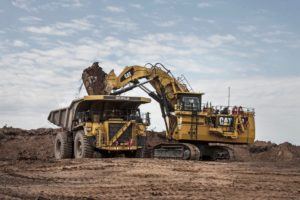Welcome to the Unicorn Club: A Billion Dollar Idea to Harness Data

How one company is attempting to harness data for historically archaic industrial applications like mining.
Data volumes are exploding. More data has been created in the past two years than in the entire previous history of the human race [1]. With big data only getting bigger, some estimate that data volumes will grow 50 times year-over-year between now and 2020 [2]. As more machines and equipment are connected to the internet and armed with sensors, there is a tremendous opportunity to collect, store, analyze and improve operations. Historically archaic industries, from extractive metals & mining to industrial manufacturing, have largely remained static for 100 years with hardly any innovation [3]. Until now.
Industrial giants have been slow-to-change, but serial entrepreneur and venture capitalist, Brad Keywell, thinks he can get them focused on data-driven innovation. To that end, he has co-founded a business, called Uptake (the “Company”), that uses sensors and gauges on industrial assets to collect billions of data points. The Company gives customers the tools and visuals to transform that data into real and measurable value. Keywell, who also holds the CEO position of Uptake, has boldly proclaimed, “The problems that we’re solving address some of the highest value-creation opportunities that I believe exist in the industrial world [2].”
Uptake, an internet software and services business, is developing solutions to harness data from sensors in real-time to provide predictive insights and actionable solutions for major industries. Uptake combines a proprietary cloud-based platform, the Uptake Core, with unique data science methods and deep industry expertise, enabling global customers to be more productive and effective [2]. In October 2015, Uptake raised $45 million of venture capital at a valuation of $1.1 billion, inducting itself into the so-called Unicorn Club (the term signifying a start-up whose valuation has exceeded the $1 billion-dollar mark) [4,5]. The Company has generated tremendous buzz, beating Slack and Uber to become Fortune’s 2015’s hottest startup [6].
Uptake operates under the premise that data is a valuable asset and competitive edge and has entered into partnerships with world class, blue chip companies to refine their solutions. The Company has partnered with industry leaders, such as Caterpillar (“CAT”), the $88 billion mining and construction equipment maker, to gain direct access to deep, rich data from sensored equipment and machines engaging in real operations [7]. On March 5, 2015, Caterpillar announced an undisclosed investment in Uptake to “jointly develop an end-to-end platform for predictive diagnostics to help Caterpillar customers monitor and optimize their fleets more effectively [8].” According to Caterpillar’s CEO, Doug Oberhelman:
“Customers use our current technology for fleet monitoring and to track fuel efficiency, idle times, location and more. Our existing solutions are effective, but it’s time we take it to the next level. This relationship will combine Caterpillar’s world-class product engineering and design expertise with Uptake’s software, application and data analytics expertise. As a result, we’ll be able to transform the quintillion bytes of incoming data we see every day into useful information we feed back to our customers for on-the-spot decisions and planning purposes to further reduce owning and operating costs [8].”
While CAT’s direct investment in Uptake is a rounding error relative to their behemoth size, CAT has demonstrated deep interest in their collaboration with the Company. On October 20, 2016, CAT opened their first Chicago office near Uptake’s headquarters [9]. Uptake has assumed the role of out-of-house software development partner for CAT, who wants to harness data from machinery such as “bulldozers and hydraulic shovels and turn it into meaningful information that can help their customers catch potential maintenance issues before breakdowns occur, minimizing downtime [7].”
The solutions the Company is creating will be used for a host of industrial applications and are aimed to improve uptime, minimize failures, reduce fuel costs, and streamline operations [2]. For example “a locomotive pulling freight cars across the country sends a constant stream of data from its onboard sensors to Uptake, and the company collects that data and gives real time insights to the railroad and engineer–like how fast the train should go, whether it’s consuming fuel efficiently, and which parts may be close to breaking [6].”
Uptake has a mere 100 employees, yet its solutions are competing directly with one of the best capitalized companies in the world, General Electric, who has invested over $1 billion in the same effort [10]. Who will win this modern-day battle of David and Goliath? Only time will tell.
(Word Count: 725)
Sources:
- http://www.forbes.com/sites/bernardmarr/2015/09/30/big-data-20-mind-boggling-facts-everyone-must-read/#4a605cdb6c1d
- https://uptake.com/
- http://www.internationalresourcejournal.com/features/sep13_features/the_lack_of_innovation_in_mining.html
- https://techcrunch.com/2013/11/02/welcome-to-the-unicorn-club/
- http://www.sramanamitra.com/2016/03/31/billion-dollar-unicorns-uptake-joins-the-club/
- http://www.forbes.com/sites/briansolomon/2015/12/17/how-uptake-beat-slack-uber-to-become-2015s-hottest-startup/#7be57b305f2e
- http://fortune.com/2015/03/05/caterpillar-digs-in-to-data-analytics-investing-in-hot-startup-uptake/
- http://www.caterpillar.com/en/news/corporate-press-releases/h/caterpillar-and-uptake-to-create-analytics-solutions.html
- http://www.chicagotribune.com/bluesky/originals/ct-caterpillar-opens-chicago-office-bsi-20161020-story.html
- http://fortune.com/2015/03/05/the-race-to-the-internet-of-things/





Nice post. I’m frankly a bit surprised that Cat doesn’t already track idle time, fuel efficiency, etc. They don’t really need minute sensors to do so. I think the more interesting application of this is tracking industrial equipment as opposed to industrial vehicles. For example, what’s the throughput time of a conveyor, what are the number of stops, etc.? That information is more difficult to gather without sophisticated sensors. Does Uptake have any applications in this space?
Only time will tell, indeed. Hopefully Uptake has a first move advantage here and it’s partnership with CAT will remain strong even when GE brings its product to market. I imagine that the partnership with CAT will generate a lot of value for CAT customers by allowing them to perform preventative maintenance on machines before more expensive repairs are needed. Are the sensors mainly used for maintenance or are they able to provide data on amount of material mined? I’m not sure how the technology would work in that context but it seems like an adjacency that makes a lot of sense for their business.